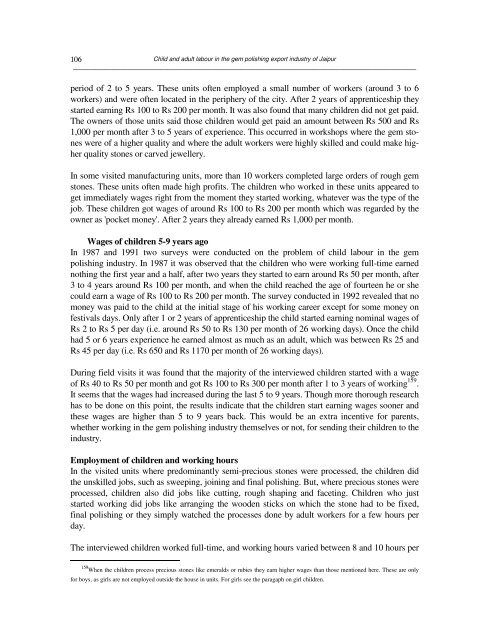Create successful ePaper yourself
Turn your PDF publications into a flip-book with our unique Google optimized e-Paper software.
106<br />
<strong>Child</strong> <strong>and</strong> <strong>adult</strong> <strong>labour</strong> <strong>in</strong> <strong>the</strong> <strong>gem</strong> polish<strong>in</strong>g <strong>export</strong> <strong>in</strong>dustry <strong>of</strong> Jaipur<br />
──────────────────────────────────────────────────────────────────────────────────────────────<br />
period <strong>of</strong> 2 to 5 years. These units <strong>of</strong>ten employed a small number <strong>of</strong> workers (around 3 to 6<br />
workers) <strong>and</strong> were <strong>of</strong>ten located <strong>in</strong> <strong>the</strong> periphery <strong>of</strong> <strong>the</strong> city. After 2 years <strong>of</strong> apprenticeship <strong>the</strong>y<br />
started earn<strong>in</strong>g Rs 100 to Rs 200 per month. It was also found that many children did not get paid.<br />
The owners <strong>of</strong> those units said those children would get paid an amount between Rs 500 <strong>and</strong> Rs<br />
1,000 per month after 3 to 5 years <strong>of</strong> experience. This occurred <strong>in</strong> workshops where <strong>the</strong> <strong>gem</strong> stones<br />
were <strong>of</strong> a higher quality <strong>and</strong> where <strong>the</strong> <strong>adult</strong> workers were highly skilled <strong>and</strong> could make higher<br />
quality stones or carved jewellery.<br />
In some visited manufactur<strong>in</strong>g units, more than 10 workers completed large orders <strong>of</strong> rough <strong>gem</strong><br />
stones. These units <strong>of</strong>ten made high pr<strong>of</strong>its. The children who worked <strong>in</strong> <strong>the</strong>se units appeared to<br />
get immediately wages right from <strong>the</strong> moment <strong>the</strong>y started work<strong>in</strong>g, whatever was <strong>the</strong> type <strong>of</strong> <strong>the</strong><br />
job. These children got wages <strong>of</strong> around Rs 100 to Rs 200 per month which was regarded by <strong>the</strong><br />
owner as 'pocket money'. After 2 years <strong>the</strong>y already earned Rs 1,000 per month.<br />
Wages <strong>of</strong> children 5-9 years ago<br />
In 1987 <strong>and</strong> 1991 two surveys were conducted on <strong>the</strong> problem <strong>of</strong> child <strong>labour</strong> <strong>in</strong> <strong>the</strong> <strong>gem</strong><br />
polish<strong>in</strong>g <strong>in</strong>dustry. In 1987 it was observed that <strong>the</strong> children who were work<strong>in</strong>g full-time earned<br />
noth<strong>in</strong>g <strong>the</strong> first year <strong>and</strong> a half, after two years <strong>the</strong>y started to earn around Rs 50 per month, after<br />
3 to 4 years around Rs 100 per month, <strong>and</strong> when <strong>the</strong> child reached <strong>the</strong> age <strong>of</strong> fourteen he or she<br />
could earn a wage <strong>of</strong> Rs 100 to Rs 200 per month. The survey conducted <strong>in</strong> 1992 revealed that no<br />
money was paid to <strong>the</strong> child at <strong>the</strong> <strong>in</strong>itial stage <strong>of</strong> his work<strong>in</strong>g career except for some money on<br />
festivals days. Only after 1 or 2 years <strong>of</strong> apprenticeship <strong>the</strong> child started earn<strong>in</strong>g nom<strong>in</strong>al wages <strong>of</strong><br />
Rs 2 to Rs 5 per day (i.e. around Rs 50 to Rs 130 per month <strong>of</strong> 26 work<strong>in</strong>g days). Once <strong>the</strong> child<br />
had 5 or 6 years experience he earned almost as much as an <strong>adult</strong>, which was between Rs 25 <strong>and</strong><br />
Rs 45 per day (i.e. Rs 650 <strong>and</strong> Rs 1170 per month <strong>of</strong> 26 work<strong>in</strong>g days).<br />
Dur<strong>in</strong>g field visits it was found that <strong>the</strong> majority <strong>of</strong> <strong>the</strong> <strong>in</strong>terviewed children started with a wage<br />
<strong>of</strong> Rs 40 to Rs 50 per month <strong>and</strong> got Rs 100 to Rs 300 per month after 1 to 3 years <strong>of</strong> work<strong>in</strong>g 159 .<br />
It seems that <strong>the</strong> wages had <strong>in</strong>creased dur<strong>in</strong>g <strong>the</strong> last 5 to 9 years. Though more thorough research<br />
has to be done on this po<strong>in</strong>t, <strong>the</strong> results <strong>in</strong>dicate that <strong>the</strong> children start earn<strong>in</strong>g wages sooner <strong>and</strong><br />
<strong>the</strong>se wages are higher than 5 to 9 years back. This would be an extra <strong>in</strong>centive for parents,<br />
whe<strong>the</strong>r work<strong>in</strong>g <strong>in</strong> <strong>the</strong> <strong>gem</strong> polish<strong>in</strong>g <strong>in</strong>dustry <strong>the</strong>mselves or not, for send<strong>in</strong>g <strong>the</strong>ir children to <strong>the</strong><br />
<strong>in</strong>dustry.<br />
Employment <strong>of</strong> children <strong>and</strong> work<strong>in</strong>g hours<br />
In <strong>the</strong> visited units where predom<strong>in</strong>antly semi-precious stones were processed, <strong>the</strong> children did<br />
<strong>the</strong> unskilled jobs, such as sweep<strong>in</strong>g, jo<strong>in</strong><strong>in</strong>g <strong>and</strong> f<strong>in</strong>al polish<strong>in</strong>g. But, where precious stones were<br />
processed, children also did jobs like cutt<strong>in</strong>g, rough shap<strong>in</strong>g <strong>and</strong> facet<strong>in</strong>g. <strong>Child</strong>ren who just<br />
started work<strong>in</strong>g did jobs like arrang<strong>in</strong>g <strong>the</strong> wooden sticks on which <strong>the</strong> stone had to be fixed,<br />
f<strong>in</strong>al polish<strong>in</strong>g or <strong>the</strong>y simply watched <strong>the</strong> processes done by <strong>adult</strong> workers for a few hours per<br />
day.<br />
The <strong>in</strong>terviewed children worked full-time, <strong>and</strong> work<strong>in</strong>g hours varied between 8 <strong>and</strong> 10 hours per<br />
159 When <strong>the</strong> children process precious stones like emeralds or rubies <strong>the</strong>y earn higher wages than those mentioned here. These are only<br />
for boys, as girls are not employed outside <strong>the</strong> house <strong>in</strong> units. For girls see <strong>the</strong> paragaph on girl children.


















